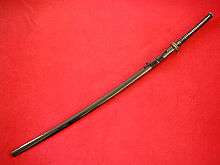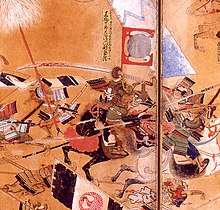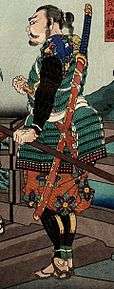Ōdachi
An ōdachi (大太刀) (large/great sword) or nodachi (野太刀, field sword)[1][2][3] was a type of traditionally made Japanese sword (日本刀, nihontō)[4][5] used by the samurai class of feudal Japan. The Chinese equivalent and 'cousin' for this type of sword in terms of weight and length is the miao dao, and the Western battlefield equivalent (though less similar) is the longsword or claymore.
.png)
The character for ō (大) means "big" or "great". The dachi here (太刀) is the same as tachi (太刀, lit. "great sword"), the older style of sword/mounts that predate the katana. The chi is also the same character as katana (刀) and the tō in nihontō (日本刀 "Japanese sword"), originally from the Chinese character for a blade, dāo.
To qualify as an ōdachi, the sword in question would have a blade length of around 3 shaku (90.9 centimetres (35.8 in)); however, as with most terms in Japanese sword arts, there is no exact definition of the size of an ōdachi.
History
In the Nanboku-chō period in the 14 century, huge Japanese swords such as ōdachi became popular. The reason for this is thought to be that the conditions for making a practical large-sized sword were established due to the nationwide spread of strong and sharp swords of the Sōshū school. In the case of ōdachi whose blade was 150 cm long, it was impossible to draw a sword from the scabbard on the waist, so people carried it on their back or had their servants carry it. Large naginata and kanabō were also popular in this period.[6] However, as infantry were equipped with yari and naginata, this fashion died out in a short period of time. Furthermore, from the Sengoku period in the latter part of the Muromachi period to the Azuchi-Momoyama period, as tactics shifted to fighting with yaris and guns by a large group of infantry, ōdachi became even more obsolete. As ōdachi became useless, it was often cut and replaced with a tachi and katana.[7]
Ōdachi was used as a weapon, but because of its magnificent appearance, it was often used as an offering to kami, a Shinto shrine. For example, Ōyamazumi Shrine, which is said to be a treasure house of Japanese swords and armor, is dedicated to the national treasure Ōdachi, which was dedicated by Emperor Go-Murakami, and ōdachi, which was dedicated by Ōmori Naoharu and killed Kusunoki Masashige.[8]
In the peaceful Edo period, ōdachi was no longer regarded as a practical weapon and came to be recognized only as an offering to the kami of Shinto shrines.
Production

Ōdachi are difficult to produce because their length makes traditional heat treatment more complicated: The longer a blade is, the more difficult (and expensive) it is to heat the whole blade to a homogeneous temperature, both for annealing and to reach the hardening temperature. The quenching process then needs a bigger quenching medium because uneven quenching might lead to warping the blade.
The method of polishing is also different. Because of their size, ōdachi are usually hung from the ceiling or placed in a stationary position to be polished, unlike normal swords which are moved over polishing stones.
In the past, acquiring a fully sharpened ōdachi was difficult, as they required special custom orders. In modern times though, many forges in Japan and China are accepting such orders due to the renewed popularity and interest in ancient Japanese weaponry in the late 20th and early 21st centuries.
Method of use


As battlefield weapons, ōdachi were too long for samurai to carry on their waists like normal swords. There were two main methods in which they could be carried. One was to carry it on one's back; however, this was seen as impractical as it was impossible for the wielder to draw it quickly. The other method was simply to carry the sheathed ōdachi by hand. The trend during the Muromachi era was for the samurai carrying the ōdachi to have a follower to help draw it.[6]
An exception does exist, though. The Kōden Enshin-ryū taught by Fumon Tanaka use a special drawing technique for "short" ōdachi allowing it to be carried on the waist. The technique is to pull out the sheath rather than drawing the blade. While this move is also used in other schools, for example, Yagyū Shinkage-ryū, Shin musō Hayashizaki-ryū and Iaidō, only Enshin-ryū seems to have used it to improve the drawing speed of an ōdachi, the other schools having used it with classical katana. The Kage-ryū style is also used to draw from the belt, using blades of approximately 2.8 shaku.
Ōdachi swordplay styles differed from that of other Japanese swords, focusing on downward cuts.
One possible use of ōdachi is as large anti-cavalry weapons, to strike down the horse as it approaches. Alternatively, it could be used as a cavalry-on-cavalry weapon comparable to the Chinese zhanmadao, with the long reach, increased weight and slashing area of the blade offering some advantages over spears, lances and smaller swords.
See also
References
- Mol, Serge (2003). Classical Weaponry of Japan: Special Weapons and Tactics of the Martial Arts. Kodansha International. p. 17.
- Fumon Tanaka (2003). Samurai Fighting Arts: the Spirit and the Practice. Kodansha International. p. 12.
- Conlan, Thomas (2003). State of War: The Violent Order of Fourteenth-century Japan. Center for Japanese Studies, University of Michigan. p. 260.
- Manouchehr Moshtagh Khorasani (2008). The Development of Controversies: From the Early Modern Period to Online Discussion Forums. Linguistic Insights. 91. Peter Lang. p. 150. ISBN 9783039117116.
- Smith, Evans Lansing; Brown, Nathan Robert (2008). The Complete Idiot's Guide to World Mythology. Complete Idiot's Guides. Penguin. p. 144. ISBN 9781592577644.
- 日本刀の歴史 南北朝時代 Touken world
- [Kazuo Tokunou 日本刀図鑑 保存版] ISBN 978-4769401285
- 大山祇神社(愛媛県今治市) Touken world
External links
| Wikimedia Commons has media related to Odachi. |
